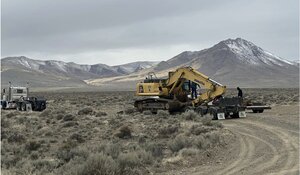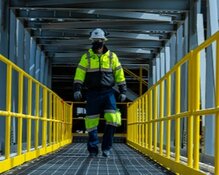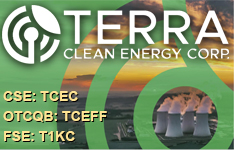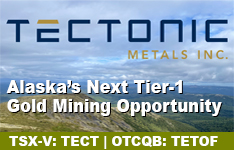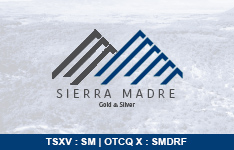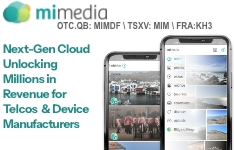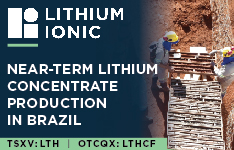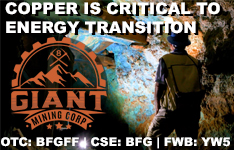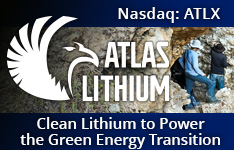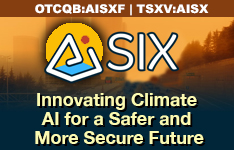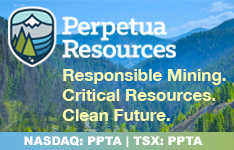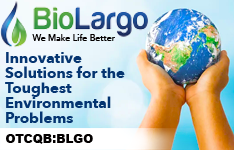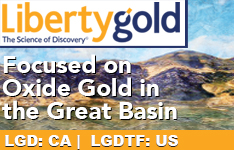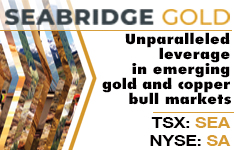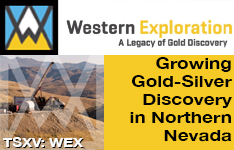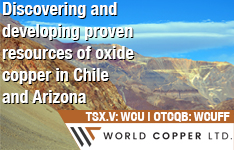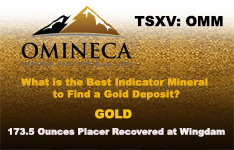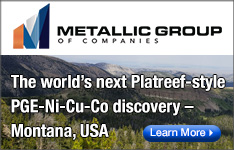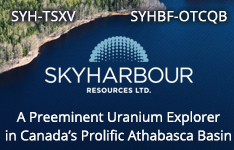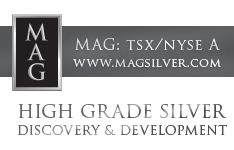Graphite One Inc. (GPH:TSX.V; GPHOF:OTCQX) reported a significant increase in its mineral reserves and resources at the Graphite Creek Project in Alaska, based on updated estimates from its 2023 and 2024 drilling programs. The company announced on March 27 that its upcoming feasibility study (FS), to be filed in April 2025, will show a 217% increase in Proven and Probable Mineral Reserve tonnage compared to its 2022 pre-feasibility study (PFS), with contained graphite increasing by196%.
The updated FS is expected to include 71.2 million tonnes of Proven and Probable reserves at an average diluted grade of 5.2% graphite, resulting in 3.72 million tonnes of contained graphite. This compares to the PFS figures of 22.5 million tonnes at 5.6% graphite or 1.26 million tonnes of contained graphite. The reserve estimates are based on a variable cut-off grade between 2% and 3% carbon in graphite (Cg), adjusted to optimize secondary treatment production. The average graphite price used in the economic modeling was US$1,200 per tonne, including transport and treatment charges.
The resource base also expanded significantly. Measured and Indicated Resources increased from 32.54 million tonnes at 5.3% Cg in the PFS to 104.7 million tonnes at 4.6% Cg in the FS. Inferred Resources rose slightly to 268.1 million tonnes, albeit at a lower average grade of 4.3%.
Graphite One's CEO, Anthony Huston, credited the U.S. Department of Defense's funding under the Defense Production Act Title III for enabling the accelerated study timeline and a quadrupling of the company's planned drilling. "We will now enter the permitting process with a production rate triple what we projected just over two years ago," Huston said in a company news release.
Located approximately 38 miles north of Nome, the Graphite Creek deposit spans 23,680 acres of State of Alaska mining claims. The reserve footprint outlined in the feasibility study covers just 1.2 miles of the 9.5-mile geophysical anomaly along the Kigluaik Mountains, suggesting additional upside pending future exploration. All resources are reported in accordance with National Instrument 43-101 and the Canadian Institute of Mining (CIM) standards.
The company also positioned its resource growth in the context of U.S. policy and supply chain concerns. In the same release, Graphite One referenced a recent Executive Order from President Trump focused on boosting American mineral production and reiterated its role in reducing the nation's 100% reliance on imported graphite.
Critical Minerals Sector: Strengthening Domestic Supply Chains Through Circularity, Policy, and Demand
According to a March 21 report from GoldFix, President Trump issued an executive order invoking the Defense Production Act (DPA) to boost U.S. production of critical minerals. The order called for expedited permitting, prioritization of federal lands for mineral development, and direct federal support for domestic projects.
In the text of the executive order, Trump stated, "Overbearing federal regulation has eroded our nation's mineral production" and described the foreign dominance in mineral supply as a "national security risk." The order specifically included graphite among key materials targeted for accelerated domestic output.
This followed a series of export restrictions enacted by China in late 2023, which disrupted supplies of several strategic materials and underscored the vulnerability of U.S. manufacturers to overseas supply chains. The executive order built upon earlier DPA-related actions taken by the Biden administration, which also allocated US$750 million in support of battery mineral development in recent years.
On March 26, Stockhead highlighted ongoing investor and regulatory focus on battery minerals such as lithium and graphite. Reporting on market trends, the publication noted that several companies gained strategic recognition under the European Union's Critical Raw Materials Act, a policy framework created to secure local sourcing of battery materials. The article pointed to graphite developers among the day's top market movers, attributing part of the activity to the increasing strategic value placed on these resources. Despite broader economic headwinds, Stockhead wrote that "the strong-ish showing in the resources sector... happened despite some individual losses," suggesting continued investor appetite for companies engaged in the exploration and development of battery-related materials.
In parallel, the Global Battery Alliance (GBA) advanced its agenda for building a sustainable and circular critical minerals value chain. Through its Circularity & Critical Minerals Advisory Group (CCMAG), the GBA released a series of white papers in early 2024 that outlined systemic changes needed to promote recycling, data transparency, and equitable stakeholder engagement. One such paper, Powering the Future: Overcoming Battery Supply Chain Challenges with Circularity, identified "the need for harmonized policy frameworks" to strengthen material flows for lithium-ion battery production and reuse. The GBA emphasized that graphite, along with lithium, cobalt, and nickel, formed the backbone of these efforts and would require large-scale investment and collaboration across public and private sectors.
The same initiative developed an analytical model, in partnership with Deloitte Belgium, to estimate future battery recycling projections, with regional insights for the U.S. included. This research highlighted the uncertainties and sensitivities in battery end-of-life management, indicating that circularity strategies must account for material-specific challenges in graphite recovery and reuse.
The GBA further noted that its CCMAG platform was designed to deepen multistakeholder collaboration and to produce guidance on ESG (environmental, social, and governance) issues for mineral producers and users alike. The advisory group was tasked with strengthening cooperation between mineral-rich governments and downstream users, emphasizing the importance of socio-economic development and transparency in sourcing practices.
Project Outlook and Near-Term Catalysts
Graphite One is developing a vertically integrated supply chain for advanced graphite materials in the United States, with the Graphite Creek mine as its foundation and a downstream anode active material (AAM) manufacturing facility planned for Niles, Ohio. As detailed in its investor presentation, the manufacturing site is designed to produce both natural and synthetic graphite-based materials, targeting the electric vehicle battery and energy storage sectors. The facility will also house a recycling operation to recover graphite and other battery materials, completing what the company describes as a circular economy model.
The Ohio facility will be developed in three phases. Phase 1, expected to be completed by the end of 2027, will establish a finishing and blending plant capable of producing 5,000 tonnes per year of AAM. Phase 2, scheduled for the end of 2029, aims to increase capacity to 25,000 tonnes per year and include a 1,000-tonne precursor plant and a 25,000-tonne graphitization line. By 2032, the facility is expected to reach 100,000 tonnes of annual AAM production through the addition of modular expansions. All timelines are contingent on project financing and permitting.
In support of these development plans, Graphite One has signed exclusive technology licensing and consulting agreements with Hunan Chenyu Fuji New Energy Technology Co., granting access to commercial-scale anode manufacturing processes. Chenyu will provide technical support for the Ohio facility's design and construction, with milestone-based consulting agreements in place. The company also holds a non-binding supply agreement with Lucid Motors for 5,000 tonnes of annual AAM production.
In terms of funding, Graphite One has received a US$37.5 million grant from the U.S. Department of Defense and holds a US$325 million non-binding letter of interest for project financing through the Export-Import Bank of the United States. In Alaska, the company has also received a US$2.0 million strategic investment from Bering Straits Native Corporation with an option to invest a further US$8.4 million to support regional engagement and development. Permitting activities for the Graphite Creek mine are scheduled to begin following the filing of the feasibility study in Q2 2025, with mine construction targeted for 2027.
Third-Party Expert Analysis
Graphite One received extensive positive assessments from analysts and commentators in the first quarter of 2025, particularly regarding its integrated graphite supply chain strategy and alignment with recent U.S. government policy directives. According to Ahead of the Herd on March 21, Graphite One's vertically integrated model of mining, processing, and recycling graphite domestically represented "a U.S. first." The article emphasized that the company was "well positioned for this new focus on bringing projects into production," referencing Graphite One's inclusion in the U.S. government's critical minerals strategy under the Defense Production Act (DPA) and its receipt of a US$37.5 million DPA grant for feasibility work.
In the same report, Ahead of the Herd noted that Graphite One had been awarded an additional US$4.7 million grant from the Department of Defense to develop a graphite-based firefighting foam alternative. These grants, along with a US$325 million non-binding Letter of Interest from the Export-Import Bank of the United States (EXIM) for the construction of the company's Ohio-based anode manufacturing plant, were cited as key signs of momentum. The article added that "G1 qualifies for federal loan guarantees worth US$72 billion," further underlining the level of institutional support available to the company.
 Streetwise Ownership Overview*
Streetwise Ownership Overview*
Graphite One Inc. (GPH:TSX.V;GPHOF:OTCQX)
Political backing for the project was also highlighted, with Ahead of the Herd stating that the company had received support from the White House, the Department of the Interior, Alaska's senators and governor, and the Bering Straits Native Corporation. The publication reported that Graphite One was viewed as a pivotal player in reducing U.S. dependency on Chinese graphite exports, especially after China imposed new restrictions on flake graphite shipments.
In a press release cited in the article, Senior Vice President of Mining Mike Schaffner stated that "the continued expansion of our Graphite Creek resource will support our plan to quadruple the annual production from our PFS study," according to Ahead of the Herd. The publication reported that the feasibility study, expected in April, would outline a larger mine and a processing plant in Ohio and that construction could begin by 2027, subject to permitting and financing.
Ownership and Share Structure
According to Refinitiv, 2.4% of Graphite One is owned by management and insiders, while 28% is held by the strategic entity Taiga Mining Co Inc. Institutions hold 0.30%. The rest is retail.
Graphite One has 145.73 million outstanding shares, 101.43 million free float shares, and a market cap of CA$92.88 million. Its 52 week range is CA$0.43 - 0.86.
| Want to be the first to know about interesting Critical Metals investment ideas? Sign up to receive the FREE Streetwise Reports' newsletter. | Subscribe |
Important Disclosures:
1) James Guttman wrote this article for Streetwise Reports LLC and provides services to Streetwise Reports as an employee.
2) This article does not constitute investment advice and is not a solicitation for any investment. Streetwise Reports does not render general or specific investment advice and the information on Streetwise Reports should not be considered a recommendation to buy or sell any security. Each reader is encouraged to consult with his or her personal financial adviser and perform their own comprehensive investment research. By opening this page, each reader accepts and agrees to Streetwise Reports' terms of use and full legal disclaimer. Streetwise Reports does not endorse or recommend the business, products, services or securities of any company.
For additional disclosures, please click here.



